Importance of Interpersonal Communication and Persuasion in Management
VerifiedAdded on 2023/06/12
|9
|2318
|216
AI Summary
This report provides an overview of the meaning and importance of interpersonal communication. It introduces the main elements involved in the process of communication and highlights the importance of effective communication skills at the workplace as well as in other situations of life. The report also describes the art of persuasion, a term of communication that helps in developing impressive communication skills in an individual. The importance of persuasion skills and the art of persuasion are also discussed in detail.
Contribute Materials
Your contribution can guide someone’s learning journey. Share your
documents today.

Running head: MANAGEMENT COMMUNICATION
management communication
management communication
Secure Best Marks with AI Grader
Need help grading? Try our AI Grader for instant feedback on your assignments.
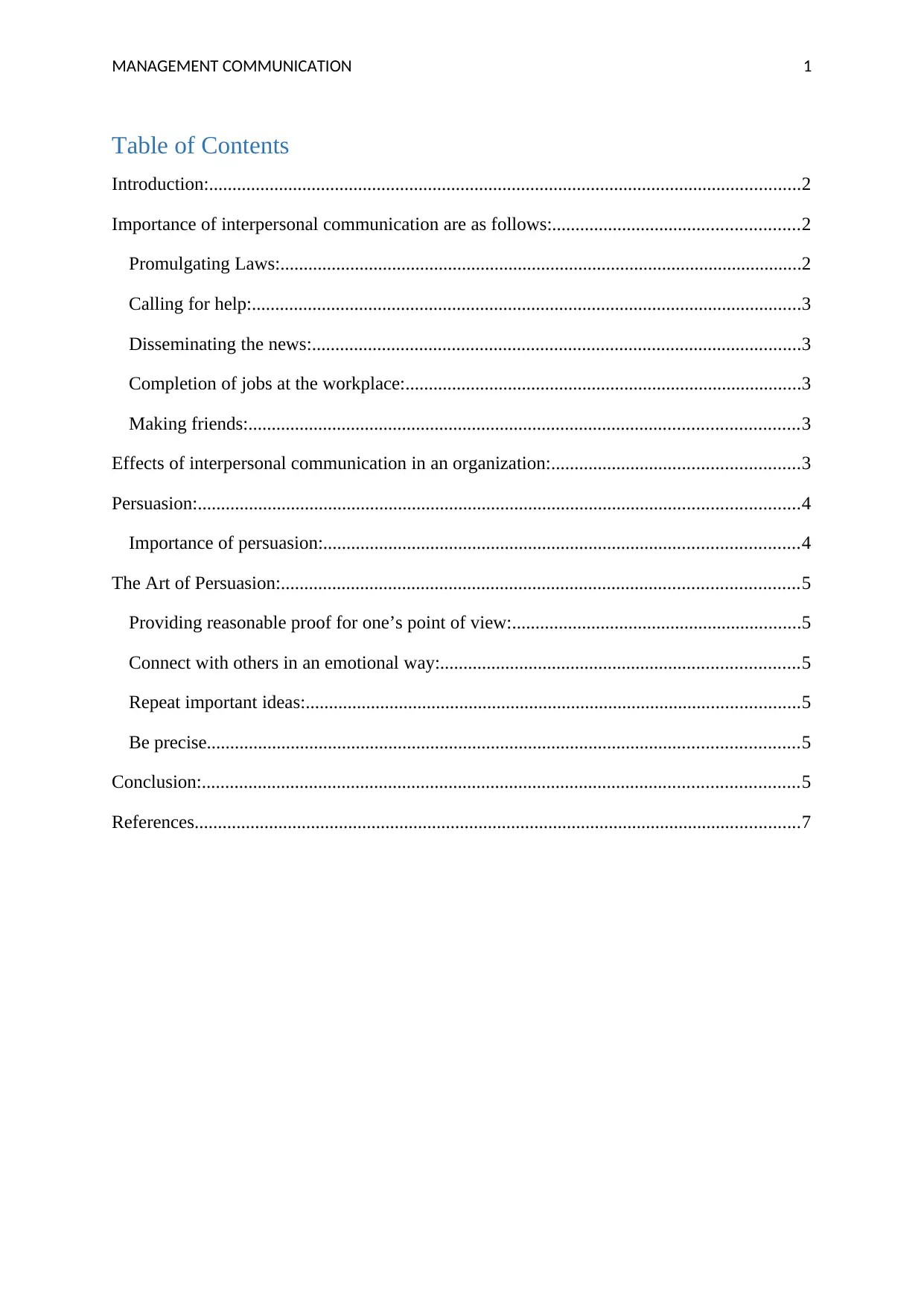
MANAGEMENT COMMUNICATION 1
Table of Contents
Introduction:...............................................................................................................................2
Importance of interpersonal communication are as follows:.....................................................2
Promulgating Laws:................................................................................................................2
Calling for help:......................................................................................................................3
Disseminating the news:.........................................................................................................3
Completion of jobs at the workplace:.....................................................................................3
Making friends:......................................................................................................................3
Effects of interpersonal communication in an organization:.....................................................3
Persuasion:.................................................................................................................................4
Importance of persuasion:......................................................................................................4
The Art of Persuasion:...............................................................................................................5
Providing reasonable proof for one’s point of view:..............................................................5
Connect with others in an emotional way:.............................................................................5
Repeat important ideas:..........................................................................................................5
Be precise...............................................................................................................................5
Conclusion:................................................................................................................................5
References..................................................................................................................................7
Table of Contents
Introduction:...............................................................................................................................2
Importance of interpersonal communication are as follows:.....................................................2
Promulgating Laws:................................................................................................................2
Calling for help:......................................................................................................................3
Disseminating the news:.........................................................................................................3
Completion of jobs at the workplace:.....................................................................................3
Making friends:......................................................................................................................3
Effects of interpersonal communication in an organization:.....................................................3
Persuasion:.................................................................................................................................4
Importance of persuasion:......................................................................................................4
The Art of Persuasion:...............................................................................................................5
Providing reasonable proof for one’s point of view:..............................................................5
Connect with others in an emotional way:.............................................................................5
Repeat important ideas:..........................................................................................................5
Be precise...............................................................................................................................5
Conclusion:................................................................................................................................5
References..................................................................................................................................7
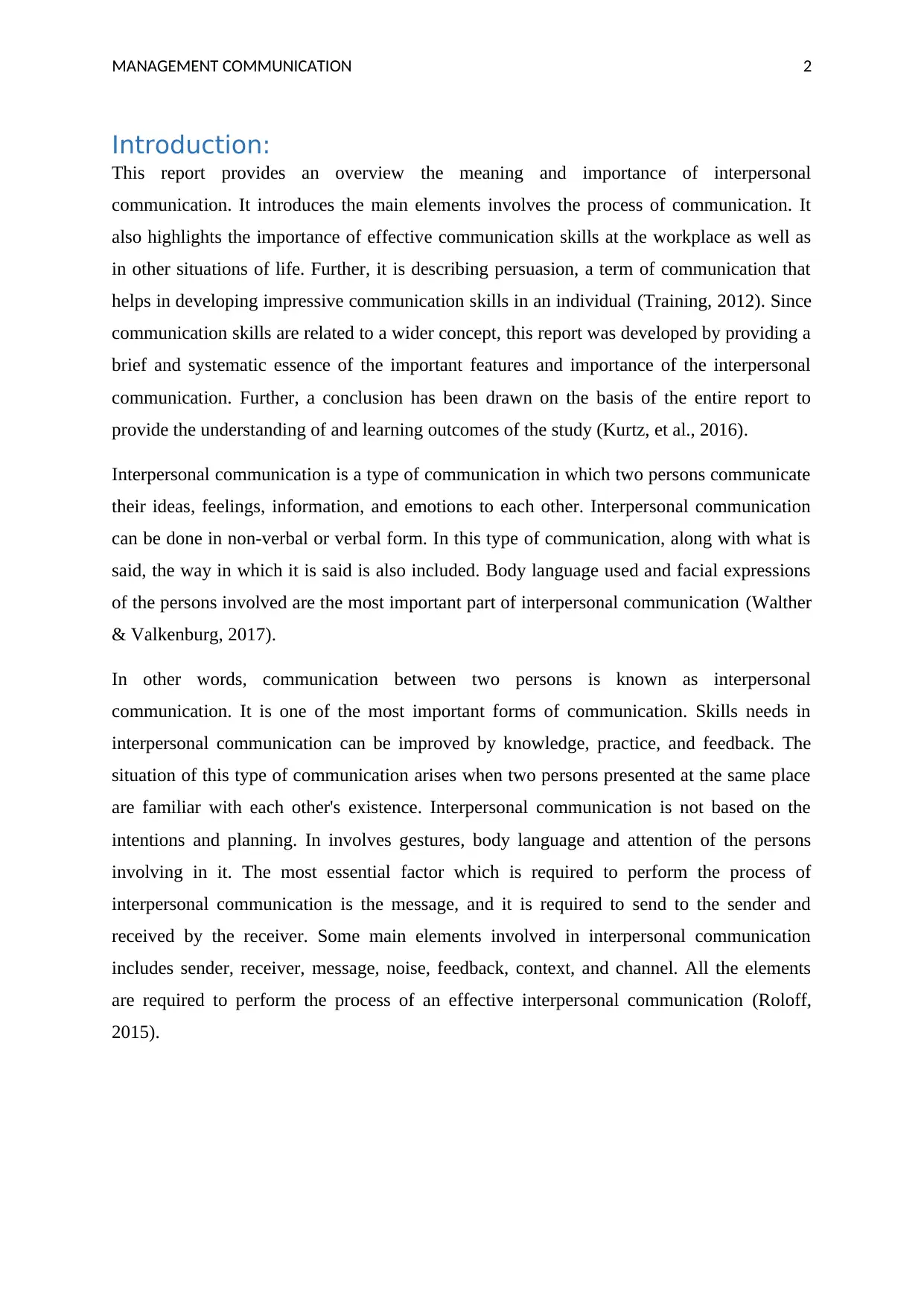
MANAGEMENT COMMUNICATION 2
Introduction:
This report provides an overview the meaning and importance of interpersonal
communication. It introduces the main elements involves the process of communication. It
also highlights the importance of effective communication skills at the workplace as well as
in other situations of life. Further, it is describing persuasion, a term of communication that
helps in developing impressive communication skills in an individual (Training, 2012). Since
communication skills are related to a wider concept, this report was developed by providing a
brief and systematic essence of the important features and importance of the interpersonal
communication. Further, a conclusion has been drawn on the basis of the entire report to
provide the understanding of and learning outcomes of the study (Kurtz, et al., 2016).
Interpersonal communication is a type of communication in which two persons communicate
their ideas, feelings, information, and emotions to each other. Interpersonal communication
can be done in non-verbal or verbal form. In this type of communication, along with what is
said, the way in which it is said is also included. Body language used and facial expressions
of the persons involved are the most important part of interpersonal communication (Walther
& Valkenburg, 2017).
In other words, communication between two persons is known as interpersonal
communication. It is one of the most important forms of communication. Skills needs in
interpersonal communication can be improved by knowledge, practice, and feedback. The
situation of this type of communication arises when two persons presented at the same place
are familiar with each other's existence. Interpersonal communication is not based on the
intentions and planning. In involves gestures, body language and attention of the persons
involving in it. The most essential factor which is required to perform the process of
interpersonal communication is the message, and it is required to send to the sender and
received by the receiver. Some main elements involved in interpersonal communication
includes sender, receiver, message, noise, feedback, context, and channel. All the elements
are required to perform the process of an effective interpersonal communication (Roloff,
2015).
Introduction:
This report provides an overview the meaning and importance of interpersonal
communication. It introduces the main elements involves the process of communication. It
also highlights the importance of effective communication skills at the workplace as well as
in other situations of life. Further, it is describing persuasion, a term of communication that
helps in developing impressive communication skills in an individual (Training, 2012). Since
communication skills are related to a wider concept, this report was developed by providing a
brief and systematic essence of the important features and importance of the interpersonal
communication. Further, a conclusion has been drawn on the basis of the entire report to
provide the understanding of and learning outcomes of the study (Kurtz, et al., 2016).
Interpersonal communication is a type of communication in which two persons communicate
their ideas, feelings, information, and emotions to each other. Interpersonal communication
can be done in non-verbal or verbal form. In this type of communication, along with what is
said, the way in which it is said is also included. Body language used and facial expressions
of the persons involved are the most important part of interpersonal communication (Walther
& Valkenburg, 2017).
In other words, communication between two persons is known as interpersonal
communication. It is one of the most important forms of communication. Skills needs in
interpersonal communication can be improved by knowledge, practice, and feedback. The
situation of this type of communication arises when two persons presented at the same place
are familiar with each other's existence. Interpersonal communication is not based on the
intentions and planning. In involves gestures, body language and attention of the persons
involving in it. The most essential factor which is required to perform the process of
interpersonal communication is the message, and it is required to send to the sender and
received by the receiver. Some main elements involved in interpersonal communication
includes sender, receiver, message, noise, feedback, context, and channel. All the elements
are required to perform the process of an effective interpersonal communication (Roloff,
2015).
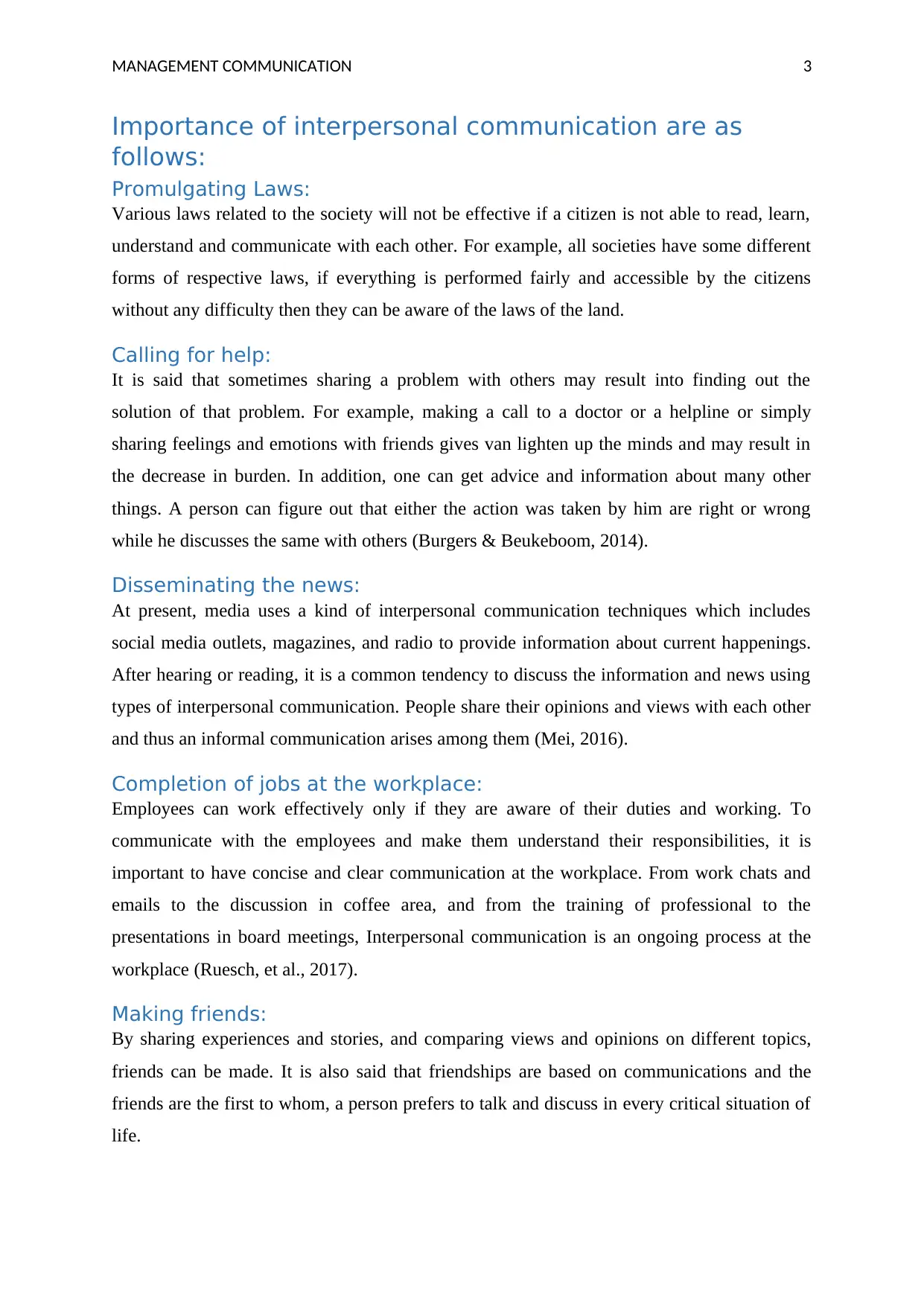
MANAGEMENT COMMUNICATION 3
Importance of interpersonal communication are as
follows:
Promulgating Laws:
Various laws related to the society will not be effective if a citizen is not able to read, learn,
understand and communicate with each other. For example, all societies have some different
forms of respective laws, if everything is performed fairly and accessible by the citizens
without any difficulty then they can be aware of the laws of the land.
Calling for help:
It is said that sometimes sharing a problem with others may result into finding out the
solution of that problem. For example, making a call to a doctor or a helpline or simply
sharing feelings and emotions with friends gives van lighten up the minds and may result in
the decrease in burden. In addition, one can get advice and information about many other
things. A person can figure out that either the action was taken by him are right or wrong
while he discusses the same with others (Burgers & Beukeboom, 2014).
Disseminating the news:
At present, media uses a kind of interpersonal communication techniques which includes
social media outlets, magazines, and radio to provide information about current happenings.
After hearing or reading, it is a common tendency to discuss the information and news using
types of interpersonal communication. People share their opinions and views with each other
and thus an informal communication arises among them (Mei, 2016).
Completion of jobs at the workplace:
Employees can work effectively only if they are aware of their duties and working. To
communicate with the employees and make them understand their responsibilities, it is
important to have concise and clear communication at the workplace. From work chats and
emails to the discussion in coffee area, and from the training of professional to the
presentations in board meetings, Interpersonal communication is an ongoing process at the
workplace (Ruesch, et al., 2017).
Making friends:
By sharing experiences and stories, and comparing views and opinions on different topics,
friends can be made. It is also said that friendships are based on communications and the
friends are the first to whom, a person prefers to talk and discuss in every critical situation of
life.
Importance of interpersonal communication are as
follows:
Promulgating Laws:
Various laws related to the society will not be effective if a citizen is not able to read, learn,
understand and communicate with each other. For example, all societies have some different
forms of respective laws, if everything is performed fairly and accessible by the citizens
without any difficulty then they can be aware of the laws of the land.
Calling for help:
It is said that sometimes sharing a problem with others may result into finding out the
solution of that problem. For example, making a call to a doctor or a helpline or simply
sharing feelings and emotions with friends gives van lighten up the minds and may result in
the decrease in burden. In addition, one can get advice and information about many other
things. A person can figure out that either the action was taken by him are right or wrong
while he discusses the same with others (Burgers & Beukeboom, 2014).
Disseminating the news:
At present, media uses a kind of interpersonal communication techniques which includes
social media outlets, magazines, and radio to provide information about current happenings.
After hearing or reading, it is a common tendency to discuss the information and news using
types of interpersonal communication. People share their opinions and views with each other
and thus an informal communication arises among them (Mei, 2016).
Completion of jobs at the workplace:
Employees can work effectively only if they are aware of their duties and working. To
communicate with the employees and make them understand their responsibilities, it is
important to have concise and clear communication at the workplace. From work chats and
emails to the discussion in coffee area, and from the training of professional to the
presentations in board meetings, Interpersonal communication is an ongoing process at the
workplace (Ruesch, et al., 2017).
Making friends:
By sharing experiences and stories, and comparing views and opinions on different topics,
friends can be made. It is also said that friendships are based on communications and the
friends are the first to whom, a person prefers to talk and discuss in every critical situation of
life.
Secure Best Marks with AI Grader
Need help grading? Try our AI Grader for instant feedback on your assignments.
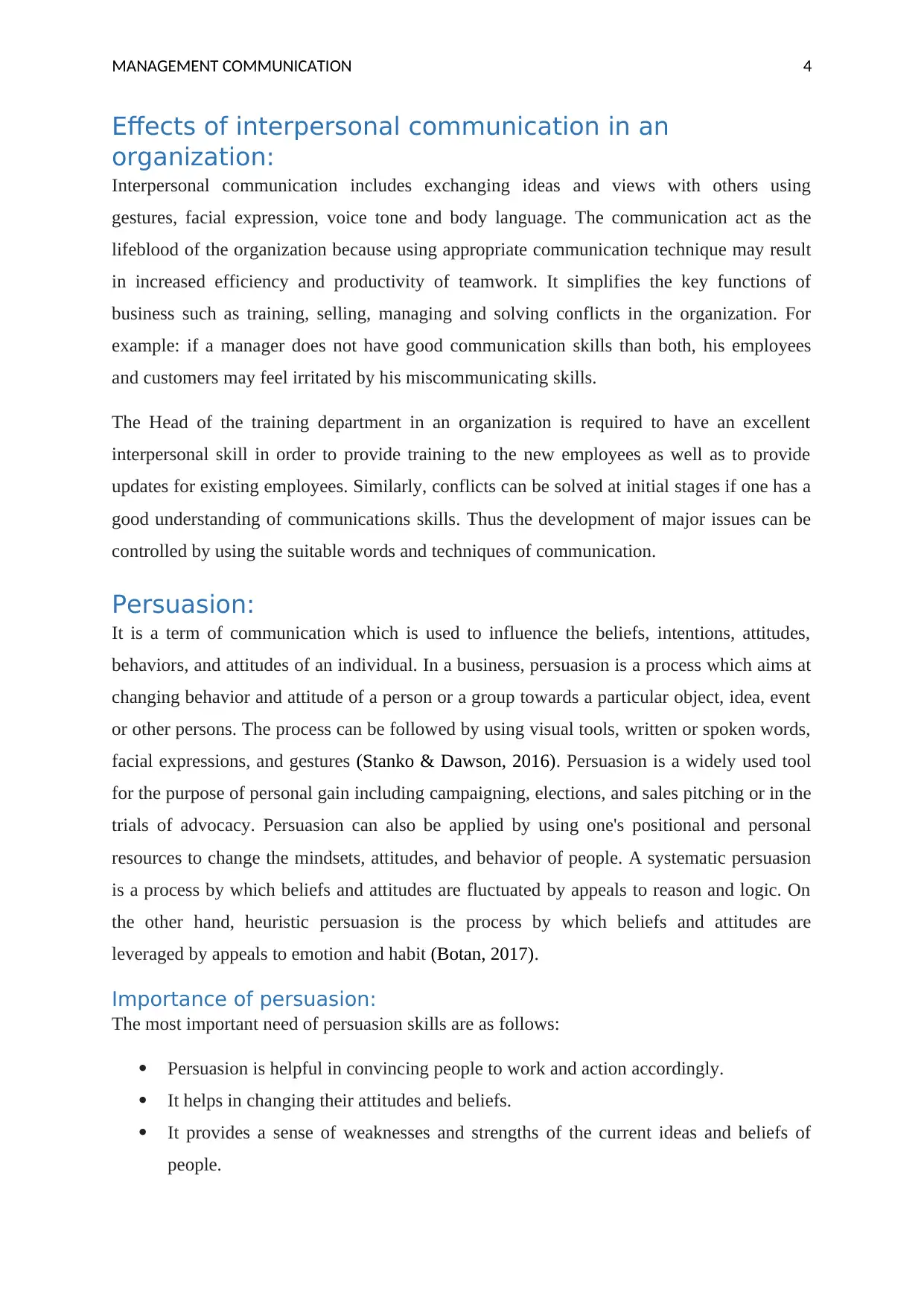
MANAGEMENT COMMUNICATION 4
Effects of interpersonal communication in an
organization:
Interpersonal communication includes exchanging ideas and views with others using
gestures, facial expression, voice tone and body language. The communication act as the
lifeblood of the organization because using appropriate communication technique may result
in increased efficiency and productivity of teamwork. It simplifies the key functions of
business such as training, selling, managing and solving conflicts in the organization. For
example: if a manager does not have good communication skills than both, his employees
and customers may feel irritated by his miscommunicating skills.
The Head of the training department in an organization is required to have an excellent
interpersonal skill in order to provide training to the new employees as well as to provide
updates for existing employees. Similarly, conflicts can be solved at initial stages if one has a
good understanding of communications skills. Thus the development of major issues can be
controlled by using the suitable words and techniques of communication.
Persuasion:
It is a term of communication which is used to influence the beliefs, intentions, attitudes,
behaviors, and attitudes of an individual. In a business, persuasion is a process which aims at
changing behavior and attitude of a person or a group towards a particular object, idea, event
or other persons. The process can be followed by using visual tools, written or spoken words,
facial expressions, and gestures (Stanko & Dawson, 2016). Persuasion is a widely used tool
for the purpose of personal gain including campaigning, elections, and sales pitching or in the
trials of advocacy. Persuasion can also be applied by using one's positional and personal
resources to change the mindsets, attitudes, and behavior of people. A systematic persuasion
is a process by which beliefs and attitudes are fluctuated by appeals to reason and logic. On
the other hand, heuristic persuasion is the process by which beliefs and attitudes are
leveraged by appeals to emotion and habit (Botan, 2017).
Importance of persuasion:
The most important need of persuasion skills are as follows:
Persuasion is helpful in convincing people to work and action accordingly.
It helps in changing their attitudes and beliefs.
It provides a sense of weaknesses and strengths of the current ideas and beliefs of
people.
Effects of interpersonal communication in an
organization:
Interpersonal communication includes exchanging ideas and views with others using
gestures, facial expression, voice tone and body language. The communication act as the
lifeblood of the organization because using appropriate communication technique may result
in increased efficiency and productivity of teamwork. It simplifies the key functions of
business such as training, selling, managing and solving conflicts in the organization. For
example: if a manager does not have good communication skills than both, his employees
and customers may feel irritated by his miscommunicating skills.
The Head of the training department in an organization is required to have an excellent
interpersonal skill in order to provide training to the new employees as well as to provide
updates for existing employees. Similarly, conflicts can be solved at initial stages if one has a
good understanding of communications skills. Thus the development of major issues can be
controlled by using the suitable words and techniques of communication.
Persuasion:
It is a term of communication which is used to influence the beliefs, intentions, attitudes,
behaviors, and attitudes of an individual. In a business, persuasion is a process which aims at
changing behavior and attitude of a person or a group towards a particular object, idea, event
or other persons. The process can be followed by using visual tools, written or spoken words,
facial expressions, and gestures (Stanko & Dawson, 2016). Persuasion is a widely used tool
for the purpose of personal gain including campaigning, elections, and sales pitching or in the
trials of advocacy. Persuasion can also be applied by using one's positional and personal
resources to change the mindsets, attitudes, and behavior of people. A systematic persuasion
is a process by which beliefs and attitudes are fluctuated by appeals to reason and logic. On
the other hand, heuristic persuasion is the process by which beliefs and attitudes are
leveraged by appeals to emotion and habit (Botan, 2017).
Importance of persuasion:
The most important need of persuasion skills are as follows:
Persuasion is helpful in convincing people to work and action accordingly.
It helps in changing their attitudes and beliefs.
It provides a sense of weaknesses and strengths of the current ideas and beliefs of
people.
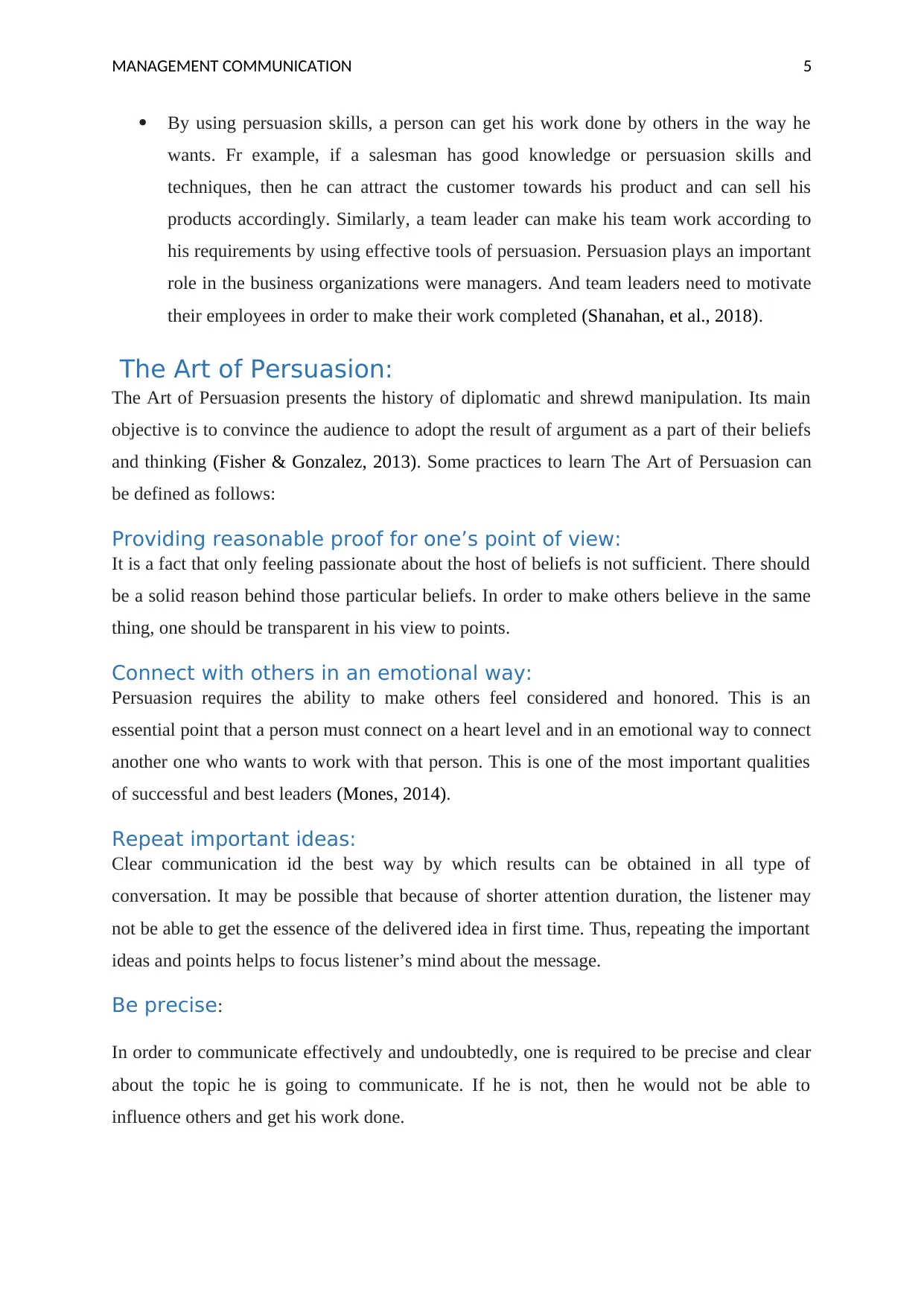
MANAGEMENT COMMUNICATION 5
By using persuasion skills, a person can get his work done by others in the way he
wants. Fr example, if a salesman has good knowledge or persuasion skills and
techniques, then he can attract the customer towards his product and can sell his
products accordingly. Similarly, a team leader can make his team work according to
his requirements by using effective tools of persuasion. Persuasion plays an important
role in the business organizations were managers. And team leaders need to motivate
their employees in order to make their work completed (Shanahan, et al., 2018).
The Art of Persuasion:
The Art of Persuasion presents the history of diplomatic and shrewd manipulation. Its main
objective is to convince the audience to adopt the result of argument as a part of their beliefs
and thinking (Fisher & Gonzalez, 2013). Some practices to learn The Art of Persuasion can
be defined as follows:
Providing reasonable proof for one’s point of view:
It is a fact that only feeling passionate about the host of beliefs is not sufficient. There should
be a solid reason behind those particular beliefs. In order to make others believe in the same
thing, one should be transparent in his view to points.
Connect with others in an emotional way:
Persuasion requires the ability to make others feel considered and honored. This is an
essential point that a person must connect on a heart level and in an emotional way to connect
another one who wants to work with that person. This is one of the most important qualities
of successful and best leaders (Mones, 2014).
Repeat important ideas:
Clear communication id the best way by which results can be obtained in all type of
conversation. It may be possible that because of shorter attention duration, the listener may
not be able to get the essence of the delivered idea in first time. Thus, repeating the important
ideas and points helps to focus listener’s mind about the message.
Be precise:
In order to communicate effectively and undoubtedly, one is required to be precise and clear
about the topic he is going to communicate. If he is not, then he would not be able to
influence others and get his work done.
By using persuasion skills, a person can get his work done by others in the way he
wants. Fr example, if a salesman has good knowledge or persuasion skills and
techniques, then he can attract the customer towards his product and can sell his
products accordingly. Similarly, a team leader can make his team work according to
his requirements by using effective tools of persuasion. Persuasion plays an important
role in the business organizations were managers. And team leaders need to motivate
their employees in order to make their work completed (Shanahan, et al., 2018).
The Art of Persuasion:
The Art of Persuasion presents the history of diplomatic and shrewd manipulation. Its main
objective is to convince the audience to adopt the result of argument as a part of their beliefs
and thinking (Fisher & Gonzalez, 2013). Some practices to learn The Art of Persuasion can
be defined as follows:
Providing reasonable proof for one’s point of view:
It is a fact that only feeling passionate about the host of beliefs is not sufficient. There should
be a solid reason behind those particular beliefs. In order to make others believe in the same
thing, one should be transparent in his view to points.
Connect with others in an emotional way:
Persuasion requires the ability to make others feel considered and honored. This is an
essential point that a person must connect on a heart level and in an emotional way to connect
another one who wants to work with that person. This is one of the most important qualities
of successful and best leaders (Mones, 2014).
Repeat important ideas:
Clear communication id the best way by which results can be obtained in all type of
conversation. It may be possible that because of shorter attention duration, the listener may
not be able to get the essence of the delivered idea in first time. Thus, repeating the important
ideas and points helps to focus listener’s mind about the message.
Be precise:
In order to communicate effectively and undoubtedly, one is required to be precise and clear
about the topic he is going to communicate. If he is not, then he would not be able to
influence others and get his work done.
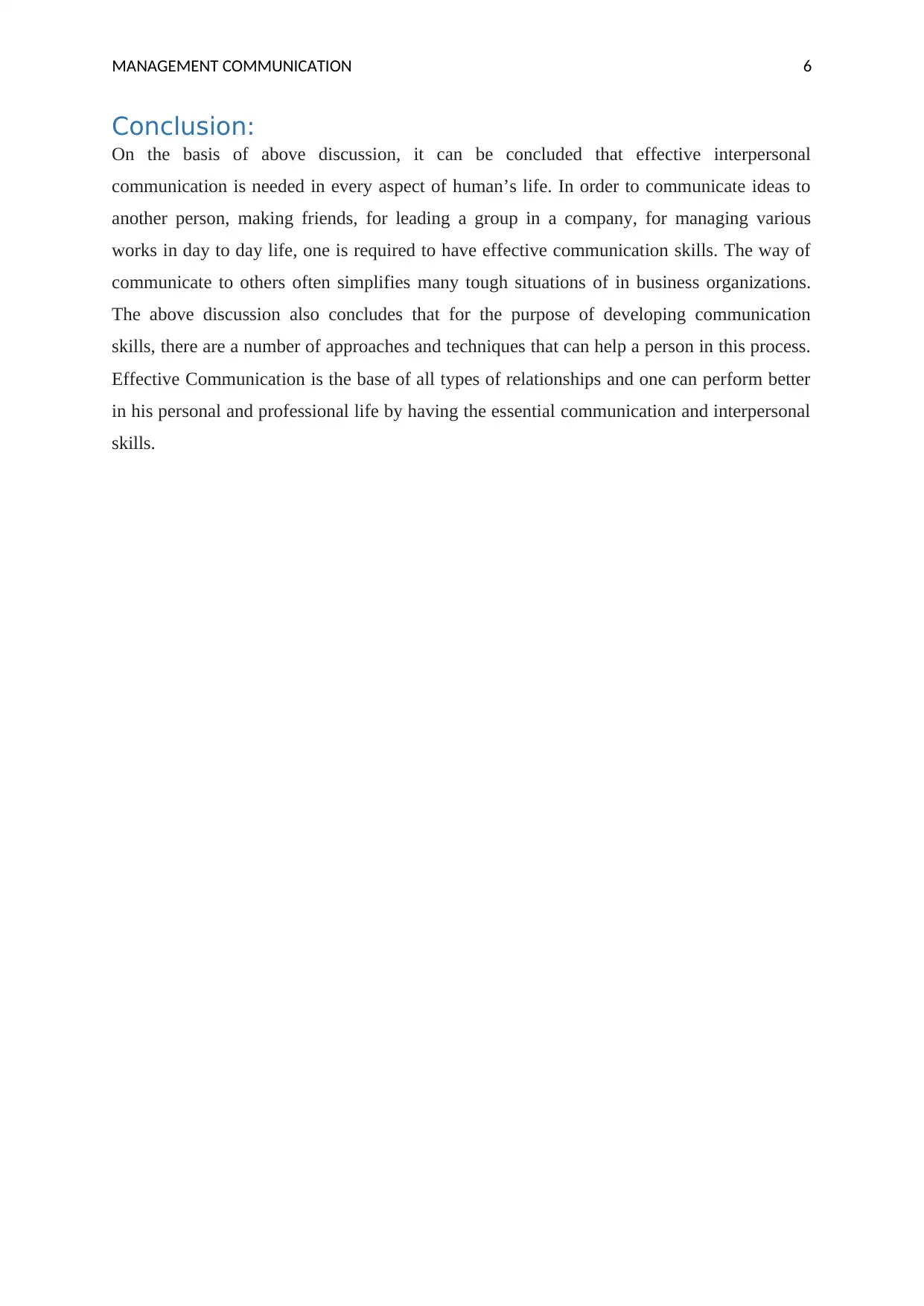
MANAGEMENT COMMUNICATION 6
Conclusion:
On the basis of above discussion, it can be concluded that effective interpersonal
communication is needed in every aspect of human’s life. In order to communicate ideas to
another person, making friends, for leading a group in a company, for managing various
works in day to day life, one is required to have effective communication skills. The way of
communicate to others often simplifies many tough situations of in business organizations.
The above discussion also concludes that for the purpose of developing communication
skills, there are a number of approaches and techniques that can help a person in this process.
Effective Communication is the base of all types of relationships and one can perform better
in his personal and professional life by having the essential communication and interpersonal
skills.
Conclusion:
On the basis of above discussion, it can be concluded that effective interpersonal
communication is needed in every aspect of human’s life. In order to communicate ideas to
another person, making friends, for leading a group in a company, for managing various
works in day to day life, one is required to have effective communication skills. The way of
communicate to others often simplifies many tough situations of in business organizations.
The above discussion also concludes that for the purpose of developing communication
skills, there are a number of approaches and techniques that can help a person in this process.
Effective Communication is the base of all types of relationships and one can perform better
in his personal and professional life by having the essential communication and interpersonal
skills.
Paraphrase This Document
Need a fresh take? Get an instant paraphrase of this document with our AI Paraphraser
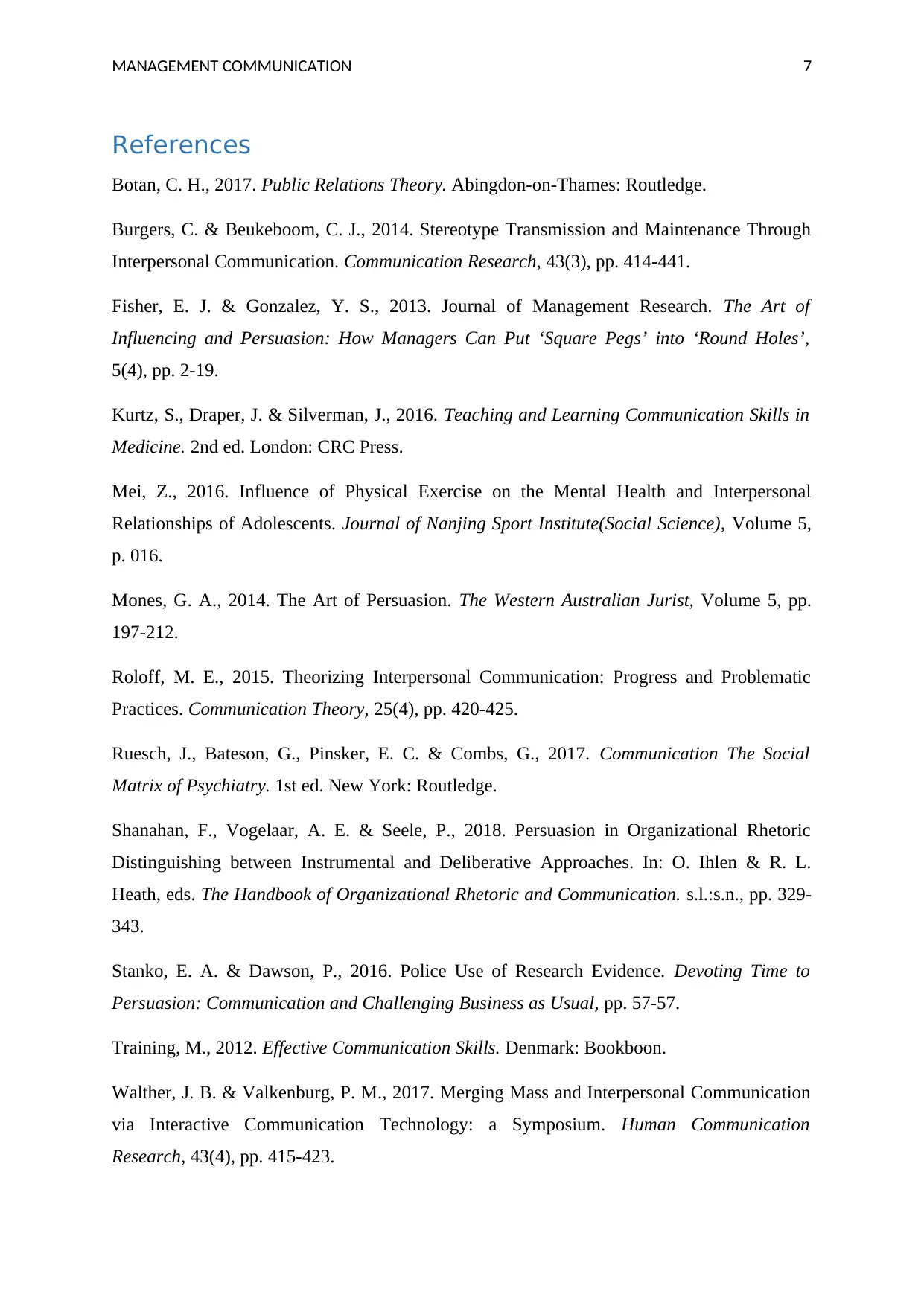
MANAGEMENT COMMUNICATION 7
References
Botan, C. H., 2017. Public Relations Theory. Abingdon-on-Thames: Routledge.
Burgers, C. & Beukeboom, C. J., 2014. Stereotype Transmission and Maintenance Through
Interpersonal Communication. Communication Research, 43(3), pp. 414-441.
Fisher, E. J. & Gonzalez, Y. S., 2013. Journal of Management Research. The Art of
Influencing and Persuasion: How Managers Can Put ‘Square Pegs’ into ‘Round Holes’,
5(4), pp. 2-19.
Kurtz, S., Draper, J. & Silverman, J., 2016. Teaching and Learning Communication Skills in
Medicine. 2nd ed. London: CRC Press.
Mei, Z., 2016. Influence of Physical Exercise on the Mental Health and Interpersonal
Relationships of Adolescents. Journal of Nanjing Sport Institute(Social Science), Volume 5,
p. 016.
Mones, G. A., 2014. The Art of Persuasion. The Western Australian Jurist, Volume 5, pp.
197-212.
Roloff, M. E., 2015. Theorizing Interpersonal Communication: Progress and Problematic
Practices. Communication Theory, 25(4), pp. 420-425.
Ruesch, J., Bateson, G., Pinsker, E. C. & Combs, G., 2017. Communication The Social
Matrix of Psychiatry. 1st ed. New York: Routledge.
Shanahan, F., Vogelaar, A. E. & Seele, P., 2018. Persuasion in Organizational Rhetoric
Distinguishing between Instrumental and Deliberative Approaches. In: O. Ihlen & R. L.
Heath, eds. The Handbook of Organizational Rhetoric and Communication. s.l.:s.n., pp. 329-
343.
Stanko, E. A. & Dawson, P., 2016. Police Use of Research Evidence. Devoting Time to
Persuasion: Communication and Challenging Business as Usual, pp. 57-57.
Training, M., 2012. Effective Communication Skills. Denmark: Bookboon.
Walther, J. B. & Valkenburg, P. M., 2017. Merging Mass and Interpersonal Communication
via Interactive Communication Technology: a Symposium. Human Communication
Research, 43(4), pp. 415-423.
References
Botan, C. H., 2017. Public Relations Theory. Abingdon-on-Thames: Routledge.
Burgers, C. & Beukeboom, C. J., 2014. Stereotype Transmission and Maintenance Through
Interpersonal Communication. Communication Research, 43(3), pp. 414-441.
Fisher, E. J. & Gonzalez, Y. S., 2013. Journal of Management Research. The Art of
Influencing and Persuasion: How Managers Can Put ‘Square Pegs’ into ‘Round Holes’,
5(4), pp. 2-19.
Kurtz, S., Draper, J. & Silverman, J., 2016. Teaching and Learning Communication Skills in
Medicine. 2nd ed. London: CRC Press.
Mei, Z., 2016. Influence of Physical Exercise on the Mental Health and Interpersonal
Relationships of Adolescents. Journal of Nanjing Sport Institute(Social Science), Volume 5,
p. 016.
Mones, G. A., 2014. The Art of Persuasion. The Western Australian Jurist, Volume 5, pp.
197-212.
Roloff, M. E., 2015. Theorizing Interpersonal Communication: Progress and Problematic
Practices. Communication Theory, 25(4), pp. 420-425.
Ruesch, J., Bateson, G., Pinsker, E. C. & Combs, G., 2017. Communication The Social
Matrix of Psychiatry. 1st ed. New York: Routledge.
Shanahan, F., Vogelaar, A. E. & Seele, P., 2018. Persuasion in Organizational Rhetoric
Distinguishing between Instrumental and Deliberative Approaches. In: O. Ihlen & R. L.
Heath, eds. The Handbook of Organizational Rhetoric and Communication. s.l.:s.n., pp. 329-
343.
Stanko, E. A. & Dawson, P., 2016. Police Use of Research Evidence. Devoting Time to
Persuasion: Communication and Challenging Business as Usual, pp. 57-57.
Training, M., 2012. Effective Communication Skills. Denmark: Bookboon.
Walther, J. B. & Valkenburg, P. M., 2017. Merging Mass and Interpersonal Communication
via Interactive Communication Technology: a Symposium. Human Communication
Research, 43(4), pp. 415-423.

MANAGEMENT COMMUNICATION 8
1 out of 9
Related Documents
Your All-in-One AI-Powered Toolkit for Academic Success.
+13062052269
info@desklib.com
Available 24*7 on WhatsApp / Email
![[object Object]](/_next/static/media/star-bottom.7253800d.svg)
Unlock your academic potential
© 2024 | Zucol Services PVT LTD | All rights reserved.




